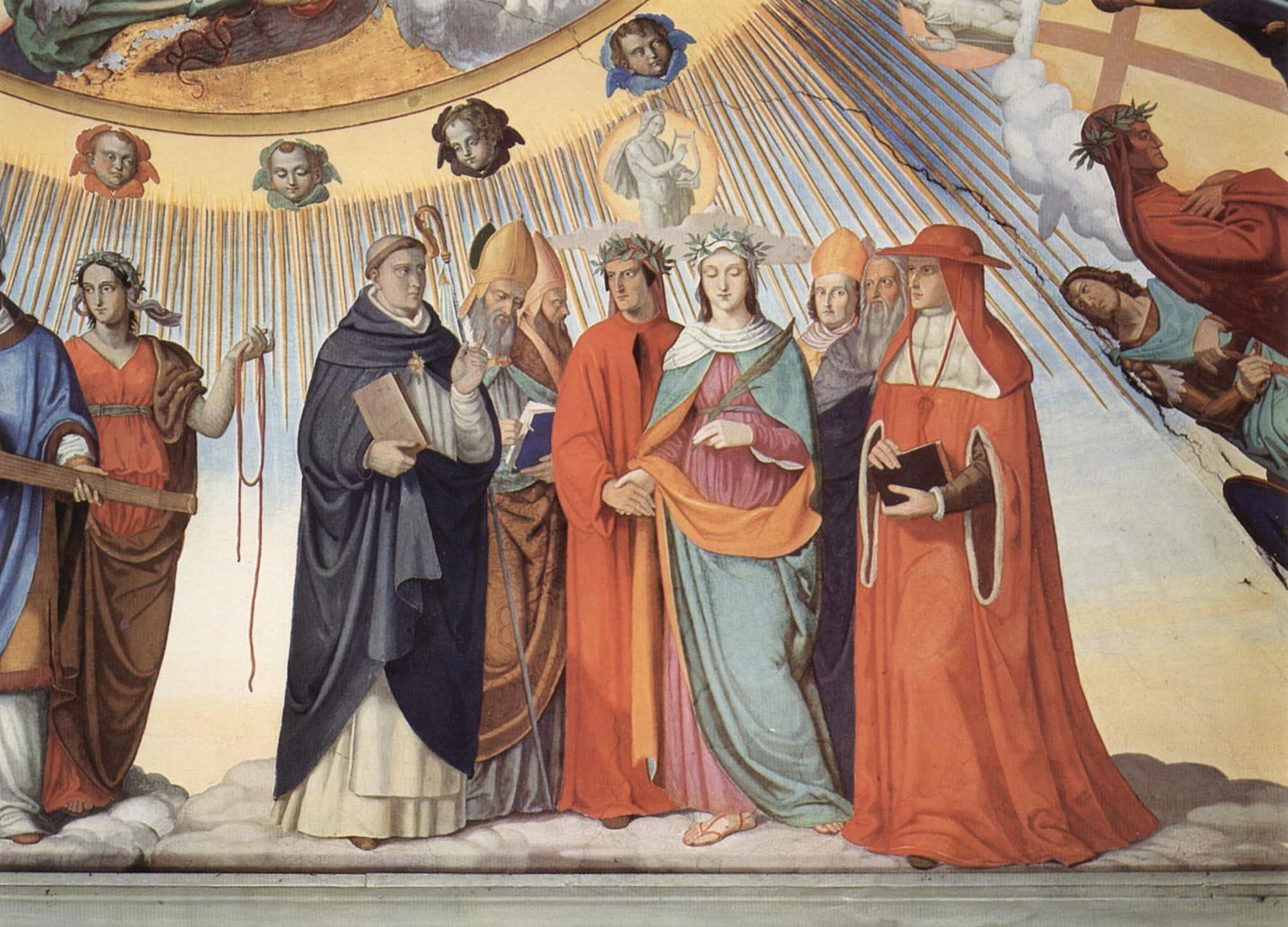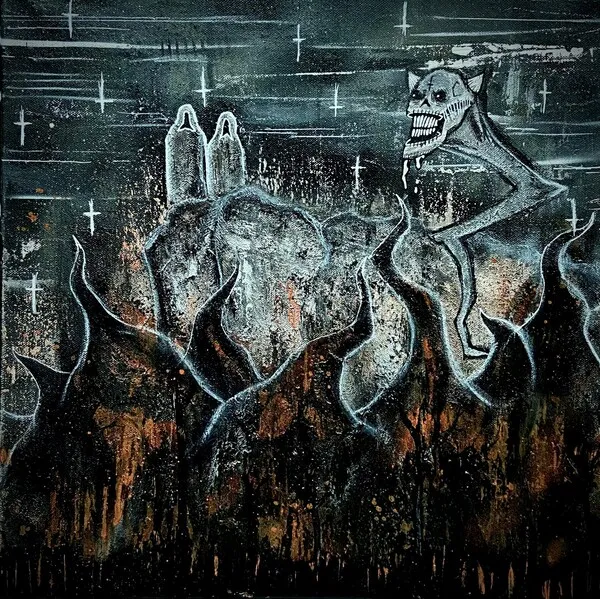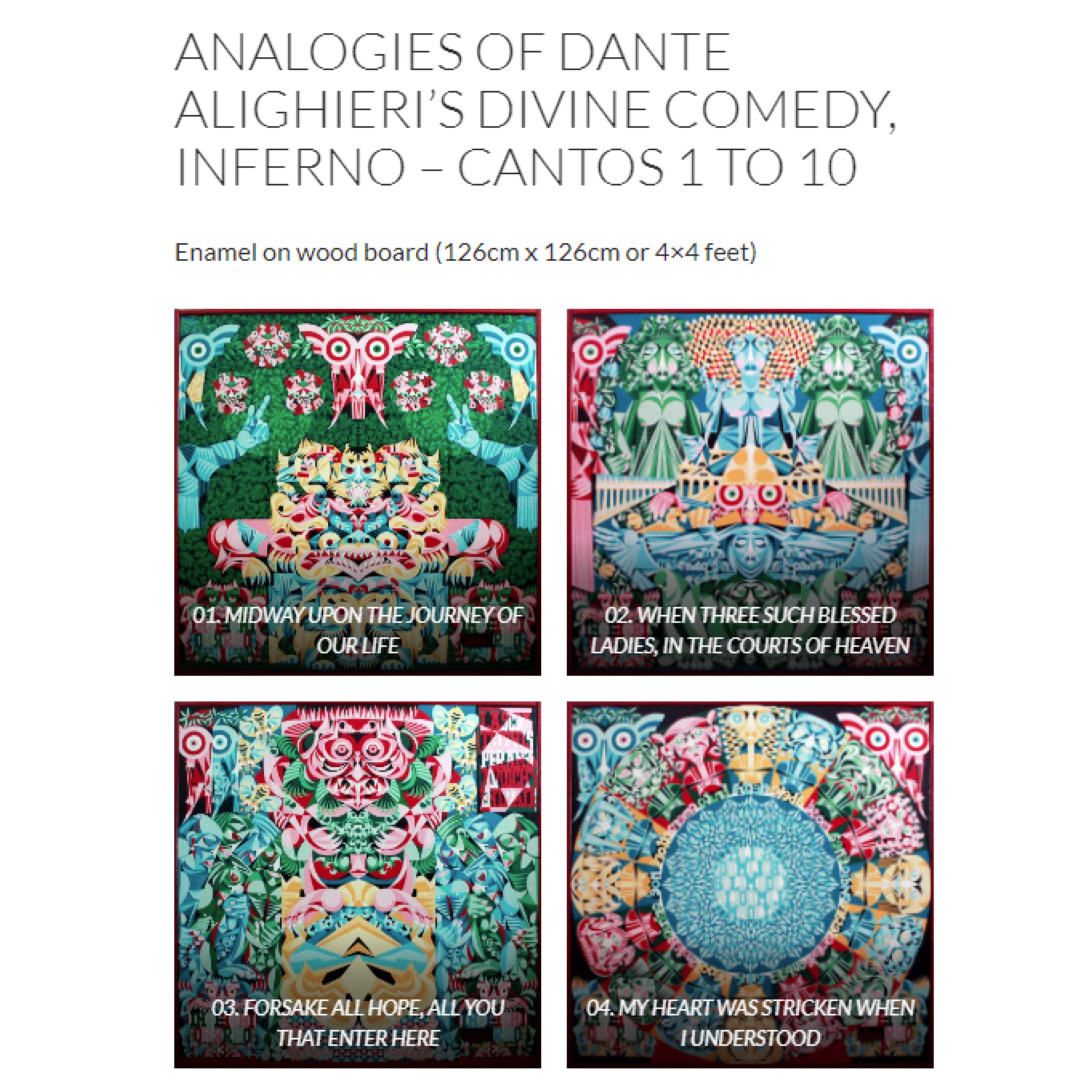Pierre Vassura, a visual artist born in Romagna, Italy, and based in British Columbia, has created a series of paintings called “ANALOGIES OF DANTE ALIGHIERI’S DIVINE COMEDY, INFERNO – CANTOS 1 TO 10.” Vassura, who paints according to a style he calls “analogical formalism,” uses enamel paint on wood panels to create his abstract depictions of each canto of the first ten cantos of Dante’s poem. See more details at Vassura Analogy Art.
“Saving Pedagogy: Dante as the Poet of Education,” Scott F. Crider

“Dante reveals to students the essence not only of their relationship to their teachers, and ours to them, but also of our combined relationship to the reality (natural, human, and divine) studied during their liberal education. The end of a liberal education is an experience of the Love that created both the subjects of a liberal education and the human persons in need of that education, and Dante achieves that purpose. Through truth and virtue, he becomes wise, and his wisdom sets him free.”
“Without ever addressing the point explicitly with students, I can let Dante reveal to them the essence not only of their relationship to their teachers, and ours to them, but also of our combined relationship to the reality (natural, human, and divine) studied during their liberal education. Dante certainly imagined liberal education as constituted by the trivium and the quadrivium—the arts of word (grammar, logic, and rhetoric) and those of number (arithmetic, geometry, astronomy, and music)—as propaedeutic to the study of philosophy and theology, and he imagined poetry, in a work he wrote on the Italian language, De vulgari eloquentia, to be the liberal art combining the consummate art of language and the consummate art of number: ‘Poetry [is] a verbal invention composed according to the rules of rhetoric and music.’ For our purposes, I will hazard a tautology and say that a liberal education liberates. That is, it frees us from error into understanding of the most significant question: How should we live?”
[. . .]
“Virgil’s guidance has been necessary for Dante, but it is not sufficient. His guidance has profound limitations that make it both helpful, given where Dante was, but needing to be surpassed, given where he is going. Imperfect pedagogy, thank goodness, can still save, just not by itself. Students need more than one teacher because of the limits of the master.”
[. . .]
“The relationship between Dante and Beatrice is a suggestive representation of the tendency in pedagogic relationships to confuse the teacher for the thing taught, and to allow one’s shared love of the material to be lost in the distracting presence of the one revealing the material. Guru-ism is a perversion of a truly saving pedagogy—a distortion of a legitimate attraction. Beauty is a salvific distraction, provided the beautiful one reminds us of that which truly saves.” — Scott F. Crider, Public Discourse, August 21, 2021
Freddie’s Inferno by Freddie Dredd
 “The title of the album, Freddie’s Inferno, is a reference to Dante’s Inferno, a poem written by Dante Alighieri in the 1300s which describes the journey through hell. The tracklist also mirrors the poem as each track is named after a circle of hell.” —Genius
“The title of the album, Freddie’s Inferno, is a reference to Dante’s Inferno, a poem written by Dante Alighieri in the 1300s which describes the journey through hell. The tracklist also mirrors the poem as each track is named after a circle of hell.” —Genius
Freddie Dredd’s songs in this album share the same names as many of the sins present in Dante’s Inferno.
“Comin’ from the underworldMy body holds a demonHeard you screamin’ for a breakI don’t think anyone could takeI’m a beast, I’m a foe, I’m the one you saw beforeDon’t be greedy with your life” –Freddie Dredd, “Greed”
Contributed by Nova Anastasia, Florida State University ’27
GAU Dante, 2021
 “GAU-Gallerie d’arte Urbana è un progetto che ha come obiettivo quello di importare un modello di risanamento urbano che riesca, a ispirare bellezza e funzionalità, attraverso la street art, applicata ad un oggetto di uso quotidiano come le campane della raccolta differenziata del vetro. Il progetto ha come obiettivo principale quello di creare un galleria d’arte urbana gratuita, fruibile in ogni momento dal cittadino, per ribadire il concetto dell’arte come bene comune, incentivando l’attenzione sulle tematiche di differenziazione dei rifiuti.
“GAU-Gallerie d’arte Urbana è un progetto che ha come obiettivo quello di importare un modello di risanamento urbano che riesca, a ispirare bellezza e funzionalità, attraverso la street art, applicata ad un oggetto di uso quotidiano come le campane della raccolta differenziata del vetro. Il progetto ha come obiettivo principale quello di creare un galleria d’arte urbana gratuita, fruibile in ogni momento dal cittadino, per ribadire il concetto dell’arte come bene comune, incentivando l’attenzione sulle tematiche di differenziazione dei rifiuti.
“Per la sua quinta edizione, GAU sceglie di omaggiare Dante Alighieri nel settimo centenario della sua morte. Gli artisti lavoreranno sui 34 canti dell’Inferno, attualizzandoli attraverso la peculiarità del proprio linguaggio artistico, reinterpretando simboli, luoghi e personaggi della Divina Commedia in chiave contemporanea.
“Moby Dick – Giusy Guerriero – Dez – Marta Quercioli – Zara Kiafar – Tito – Violetta Carpino – Kiddo – DesX – Yest – Er Pinto – Olives – Lola Poleggi – Kenji – BloodPurple – Orgh – Lady Nina – Teddy Killer – Valerio Paolucci – Wuarky – Karma Factory – Muges147 – Maudit – Hoek – Alessandra Carloni – Cipstrega – Molecole – Korvo – Alekos Reize – Gojo.” —Gallerie d’Arte Urbana
See a gallery of all 34 decorated recycling bins, one for each canto of the Inferno, on the GAU website. You can also download the magazine on the site, which includes a map where visitors to Rome can locate each bin.
The image above features Korvo’s design for cantos 30-31. Photo credit Valentino Bonacquisti.
Inferno “Illusion Dance”, NoGravity Theatre (2021)
“Un’opera d’arte completamente insolita, sorprendente e fantasiosa; l’obiettivo richiesto è innegabilmente meravigliare ma, in più, lo spettacolo si basa interamente sui gesti del corpo e su un complesso macchinario privo di qualsiasi elemento virtuale o tecnologico; c’è solo la luce che si infiltra in diagonale su un nero permanente paragonabile ai fondali dei dipinti di Caravaggio” –Antonio Audino, NoGravity Theatre
Inferno is one of the shows presented by touring theatre/dance company NoGravity Theatre. View a post about another one of their shows, Divina Commedia, here.
For more information about the show and the company, visit their website here.
- 1
- 2
- 3
- …
- 21
- Next Page »


